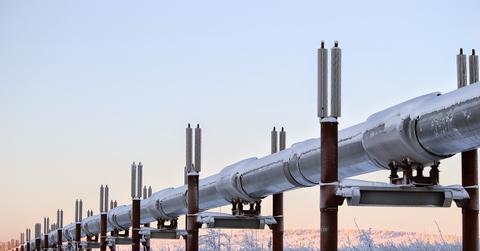Engineer Accidentally Discovers Safer Way To Transport Oil
An engineering professor from the University of Calgary has improved the way we can transport oil. Solid bitumen balls that contain oil can prevent spills that happen frequently with pipelines and rail cars.
Updated May 13 2019, 5:04 p.m. ET
While we are getting out of the fossil fuel industry, more improvements are still being made in how we use oil and gas -- sometimes accidentally. A professor at the University of Calgary was able to discover a safer way to transport petroleum, which has been a hazard to the environment for many years. It’s not expected to fully replace the convenience of pipelines, but it could provide a safer, alternative way to get the job done.
Ian Gates, who works at the Schulich School of Engineering at the University of Calgary, was attempting to upgrade bitumen in the laboratory. Bitumen is a mixture of hydrocarbons left over after oil is distilled. Traditionally, this material is used to create hard surfaces like road blacktops. However, in the process they actually degraded it, creating a thick, gummy mixture.
By doing this, petroleum could be captured as the mixture hardens. Gates and his team were able to form pebbles of oil that would harden by themselves. These balls of bitumen safely stored oil that could end up being shipped in its new form. According to Futurism, once they’ve been transported, “the pellets can be reconstituted back into bitumen using a light oil produced during the pellet-creation process.”
Gates compared the product to a gel capsule, similar to medicines that we can get over the counter. There’s a gas bubble that’s injected into each pellet, meaning that the capsule won’t break when it enters water and it can be transported by rail and truck. For example, these could be transported in rail cars that were originally for coal mining, but have since been abandoned.
Even better -- the technology used to mass create the new method used the same amount of energy when it came to preparing the old version of bitumen for shipping. This is because they can create pellets right at the wellhead. It isn’t the first time that something like this was invented, but the balls can be created without additional materials or the need for a microwave.
“Through our energy technology incubator, we were able to not only protect technology through intellectual property management, but connect with potential industry partners and customers who might help advance the technology to a field trial, and ultimately, a full scale solution,” Stace Wills, Innovate Calgary’s Vice President of Energy, said in the school’s report. Innovative Calgary helps accelerate startups and new ideas, and they backed the school's bitumen project.
This new method provides a much better alternative to pipeline or traditional rail transportation. Pipelines are easier to maintain and cheaper to actually transport petroleum, but they’re expensive to create. The popular Dakota Access Pipeline, built underground in the United States, has seen plenty of protests due to potential groundwater contamination. Even on trains, there have been a whopping 62 crude oil spills over the past decade.
While this new process from the University of Calgary won’t replace pipelines, it provides a safer mode of transportation by rail. If costs and energy usage are similar, if not safer, than traditional methods, then it’s a better way to work with oil. The bitumen balls should reach full-scale production later this year.
